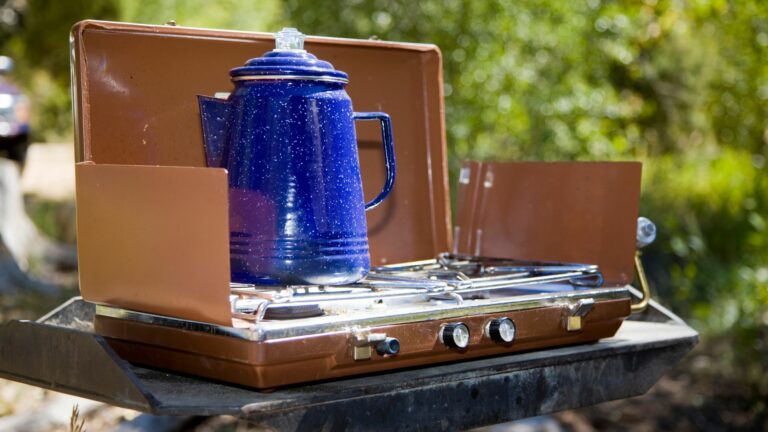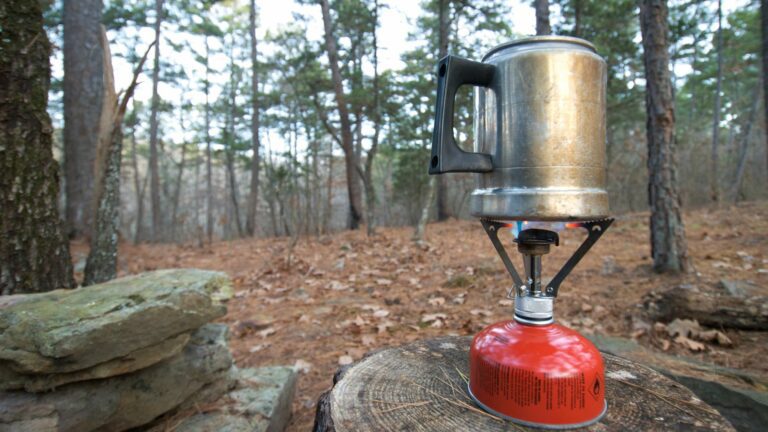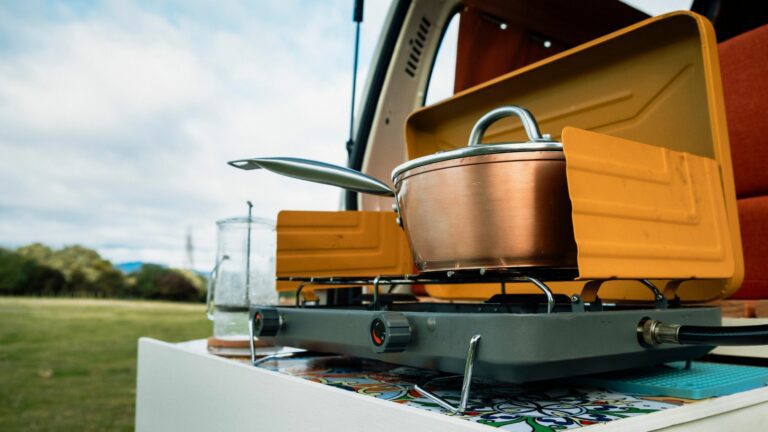When you're out in the wilderness, a reliable camping stove is essential for cooking up delicious meals and enjoying the comforts of a warm beverage.
Maintaining your camping stove is essential for its performance and longevity. Over time, dirt, food residue, and exposure to the elements can impact your stove's efficiency, leading to uneven cooking and potential safety hazards.
With a little care and attention, your camping stove will keep burning bright for many trips to come!
Did you know that 73% of camping trip disasters are caused by poorly maintained gear?
But don't worry, because I'm about to share the ultimate playbook for keeping your camping stove in tip-top shape… From simple cleaning techniques to troubleshooting common issues.
Table of Contents
Why Your Camping Stove Deserves Some TLC

Before we get started, I've got a confession to make… I used to treat my camping stove like a disposable lighter. Use it, abuse it, toss it in the camping closet, and pray it works next time.
The brutal truth is that a neglected camping stove is a disaster waiting to happen.
Just imagine being at your campsite ready to cook up a gourmet feast and you pull out your trusty stove, give it a confident shake (as if that's gonna do anything), and…. nothing… Nada… Zilch! Just a sad little hiss and the crushing realization that you'll be eating a cold can of beans for dinner instead.
Now it doesn't have to be this way! A little TLC goes a long way and I've learned that a clean, well-maintained stove can literally make or break your adventure.
Regular maintenance isn't just about keeping things sparkly clean. It's also about reliability, efficiency, and not having to explain to your hangry friends why they're eating cold beans out of a can.
First off, a well-maintained stove burns more efficiently. That means your fuel lasts longer, and you're not lugging around extra canisters like some sort of propane sherpa.
Secondly, regular maintenance helps you spot potential issues before they become full-blown disasters. You know that weird rattling sound your stove's been making? Yeah, that's not a feature. Catching these little quirks early can save you from a culinary catastrophe in the middle of nowhere.
Also, a clean stove is actually safer. It can reduce the risk of flare-ups, fuel leaks, and other scary scenarios.
And don't forget about performance. You wouldn't expect a champion racehorse to win the Kentucky Derby without proper care, right? Same goes for your camping stove. A little maintenance can mean the difference between a sad, lukewarm meal and a piping hot feast that'll make you the hero of the campsite.
The bottom line is your camping stove deserves love. So next time you're packing up after a trip, resist the urge to just toss it in the garage. Give it a quick once-over, clean out the gunk, and store it properly. Your future self (and your camping buddies) will thank you.
Cleaning Your Camping Stove
Let's break the cleaning process down, step by step. But before you get started, make sure your stove is completely cool. You don't want to end up with burnt fingers.
Step 1: Disassemble that bad boy. Take off the grates, burner heads, and any removable parts. Don't go crazy here – if something looks like it shouldn't come off, leave it be. We're cleaning a stove, not rebuilding an engine.
Step 2: Time to bust out that old toothbrush you've been meaning to throw away. Yep, that's right. Your camping stove doesn't need fancy equipment; it just needs a little elbow grease and determination.
Step 3: Get scrubbing! Use that toothbrush to get into all the nooks and crannies. Focus on the burner heads and fuel lines… that's where all the gunk likes to hide.
Step 4: For those really tough spots, here's a little DIY magic for you. Mix some baking soda with water to make a paste. This stuff is like kryptonite for camping stove grime.
Essential Tools to Use:
An old toothbrush, a sponge, and maybe some cotton swabs for those extra tight spots are all you really need. No need to buy some overpriced “specialized” cleaning kit. Save that money for more important things, like extra marshmallows.

DIY Cleaning Solutions:
Mix equal parts water and white vinegar in a spray bottle, and you've got yourself a powerful cleaner that'll cut through grease faster than a hot knife through butter.
For tougher jobs, create a baking soda paste. You can kick it up a notch by adding a little dish soap to the mix.
Keep in mind that prevention is key. After each use, give your stove a quick wipe-down with a damp cloth. It'll save you from having to do a deep clean every time.
Don't forget about the fuel line! A clogged fuel line is about as useful as a chocolate teapot. Use a pipe cleaner or a thin wire to gently clear out any debris. Just be careful not to damage anything.
A clean stove is a happy stove… And a happy stove means hot food, which means happy campers!
Maintenance Hacks That'll Make Your Stove Last Forever
Let's talk about some quick fixes that'll save your bacon (literally) when you're out in the wild.
First up, the dreaded “my stove won't light” scenario. Often, it's just a clogged fuel line or jet. Give it a gentle poke with a thin wire or a paperclip straightened out. Just don't go all Rambo on it; we're doing surgery here, not demolition.
If your flame's acting wonky, check the fuel-air mixture. There's usually a little lever or dial for that. Play around with it until you get that beautiful blue flame.
Now, let's talk preventative maintenance…
BEFORE each trip, give your stove a once-over. Check for any loose parts, give it a little shake (gently, we're not making margaritas), and make sure all the connections are tight.
AFTER your trip, don't just toss your stove in a closet and forget about it. Give it a quick clean and pay extra attention to the burner heads and fuel line. A little TLC goes a long way.
When it comes to storage of your camping stove, it's important to keep it dry. Moisture can cause rust and corrosion that can lead to a failure to operate. Before you stash your stove away for the off-season, make sure it's clean and completely dry.
Here's a little hack I picked up: toss a silica gel packet in with your stove when you store it. You know, those little “DO NOT EAT” packets that come with… well, everything these days. They're great for soaking up any lingering moisture.
And please, don't store your stove connected to the fuel canister. It's like leaving your car running in the garage – a recipe for disaster.
One last thing – and this is important – always store your stove in a cool, dry place. Not in your attic where it'll bake, or in your damp basement where it'll rust. Treat it like a fine wine, minus the aging part.
A well-maintained camping stove is like a loyal friend. It'll stick with you through thick and thin, rain or shine, gourmet meals or rehydrated space food. With these maintenance hacks, your stove will be ready to fire up delicious meals for years to come.
Fuel Management 101

Types of Fuel:
Propane: The old reliable. It's easy to use, burns clean, and works great in cold weather.
White gas (aka Coleman fuel): This stuff burns hot, works in any temperature, and lasts forever.
Isobutane-propane mix: Not too heavy, not too volatile, works pretty well in cold weather. However, it can be a bit pricier than other options.
Alcohol: The hippie fuel. It's cheap, widely available, and environmentally friendly. Great for simmering, not so much for boiling.
Storage and Handling:
Rule number one: treat your fuel with respect. This isn't a game of hot potato.
For canister fuels, always store them upright in a cool, dry place. And be sure to keep them away from heat sources.
Liquid fuels need a little extra TLC. Store them in approved containers (not your old water bottle), and keep them tightly sealed.
And PLEASE don't smoke while refueling your stove. This should be a no-brainer.
Troubleshooting:
Let's face it, stuff happens, especially when you're miles from civilization with nothing but squirrels to ask for help.
If your stove's not lighting, first check if you've actually turned on the fuel. I know, I know, it sounds obvious, but you'd be surprised how often this is the culprit.
Next, make sure your fuel line isn't clogged. A gentle poke with a thin wire can work wonders.
For those times when your flame is acting more like a sad birthday candle than a roaring campfire, check your fuel-air mixture. There's usually a little lever or dial for adjusting this.
If you're dealing with a leaky fuel connection, tighten everything up. If that doesn't work, check your O-rings.
Always carry a multipurpose tool and some spare O-rings. They weigh next to nothing and can save your trip when things go south.
Treat your fuel right, handle it with care, and always, ALWAYS pack a little extra. Because the only thing worse than no coffee in the morning is the realization that you can't even heat water for that no-coffee morning.
Upgrades and Accessories for Your Camping Stove

Game-changing accessories
A good windscreen – This is a great addition because it'll keep your flame steady even when Mother Nature decides to throw a hissy fit.
A heat diffuser – This little marvel spreads the heat evenly across your pot, preventing hot spots and burnt food. It's the difference between “who wants some camp grub?” and “who's ready for a gourmet wilderness experience?”
A gravity-fed water system – Hang this bad boy near your cooking station, and you've got instant running water. It's like having a kitchen sink in the middle of nowhere.
A flexible LED light – Get one that clips onto your stove for an easy lighting option while your cooking. You don't want to accidentally season your dinner with bug spray.
Upgrading Your Stove
When should you consider upgrading your stove? Well, if your current stove is older than your favorite pair of hiking boots, it might be time. Or if you find yourself constantly wishing for more burners, more power, or better simmer control, that's your cue.
Choosing the right stove requires you to evaluate your situation. It needs to fit your lifestyle, your needs, and the type of camping you do (car camping, campsite camping, or backpacking).
Also think about what type of camp cook you are. Are you a “boil water and add to pouch” kind of camper, or do you fancy yourself a backcountry chef?
If you're into ultralight backpacking, look for compact, lightweight stoves.
For car camping or base camp setups, you can go bigger and badder. Two-burner stoves are great for whipping up more complex meals.
Looking to upgrade your outdoor camp kitchen? Check out this article on the 10 Must-Have Camping Cookware for Outdoor Cooking. It's packed with essential gear recommendations to make your camping meals even more delicious and hassle-free!
No matter what camp stove you end up choosing, just remember to test everything at home first. The middle of the woods is a terrible place to discover you don't know how to use it.





